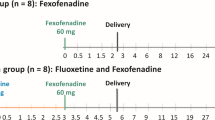Abstract
Objective
The chiral pharmacokinetics and pharmacodynamics of ritodrine in patients pregnant with singletons and twins were investigated to determine the optimal use of ritodrine.
Methods
Eight and 20 patients with threatened preterm delivery of singletons and twins, respectively, were infused with ritodrine diastereomers. Serum concentrations of the drug were then measured using a newly developed method of chiral high-performance liquid chromatography.
Results
Almost double the dosage of racemic ritodrine was required to prolong pregnancies with twins compared with those of singletons (2.20 ± 1.06 vs. 1.24 ± 0.36 μg/min per kilogram; p < 0.0001). The mean ratios of (–)-ritodrine to (+)-ritodrine in singleton and twin pregnancies were 1.17 ± 0.10 and 1.16 ± 0.10, respectively. However, the serum concentration and dosage ratio (C/D ratio) of (−)-ritodrine as significantly higher than that of (+)-ritodrine (p < 0.0001), whereas the clearance of (−)-ritodrine was significantly lower than that of (+)-ritodrine (p < 0.0001). A comparison of the gestation period (weeks) and diastereomer clearance did not reveal significant regression in the total analysis of the data obtained from singleton and twin pregnancies.
Conclusion
These results indicate that the clinical effectiveness of ritodrine diastereomers should be evaluated and that administration guidelines should be established based upon serum concentrations so that ritodrine can be more effectively administered to pregnant patients carrying either singletons or twins.



Similar content being viewed by others
References
Caritis SN (1988) A pharmacologic approach to the infusion of ritodrine. Am J Obstet Gynecol 158:380–384
Kuhnert BR, Gross TL, Kuhnert PM, Erhard P, Brashar WT (1986) Ritodrine pharmacokinetics. Clin Pharmacol Ther 40:656–664
Caritis SN, Lin LS, Wong LK (1985) Evaluation of the pharmacodynamics and pharmacokinetics of ritodrine when administered as a loading dose. On establishing a potentially useful drug administration regimen in cases of fetal distress. Am J Obstet Gynecol 152:1026–1031
Caritis SN, Venkataramanan R, Darby MJ, Chiao JP, Krew M (1990) Pharmacokinetics of ritodrine administered intravenously: recommendations for changes in the current regimen. Am J Obstet Gynecol 162:429–437
Neri I, Monari F, Valensise H, Vasapollo B, Facchinetti F, Volpe A (2008) Computerized evaluation of fetal heart rate during tocolytic treatment: comparison between atosiban and ritodrine. Am J Perinatol 26(4):259–263
Chan TF, Chung YF, Chen HS, Su JH, Yuan SS (2004) Elevated amniotic fluid leptin levels in early second trimester are associated with earlier delivery and lower birthweight in twin pregnancy. Acta Obstet Gynecol Scand 83:707–710
Norwitz ER, Edusa V, Park JS (2005) Maternal physiology and complications of multiple pregnancy. Semin Perinatol 29:338–348
Caritis SN, Lin LS, Toig G, Wong LK (1983) Pharmacodynamics of ritodrine in pregnant women during preterm labor. Am J Obstet Gynecol 147:752–759
Konda A, Nodai A, Soma M, Koga Y, Yoshida H, Toda T, Hayakawa T, Inotsume N (2008) Ritodrine pharmacokinetics in twin pregnancy patients. Eur J Clin Pharmacol 64:399–404
Yamasaki N, Fukuda Y, Shibazaki Y, Niizato T, Kosugi I, and Yoshioka S (1995) (-)-ritodrine, therapeutic compositions and use, and method of preparation. US Patent 5449694.
O’Reilly RA (1974) Interaction of sodium warfarin and rifampin. Studies in man. Ann Intern Med 81:337–340
Hayakawa I, Atarashi S, Yokohama S, Imamura M, Sakano K, Furukawa M (1986) Synthesis and antibacterial activities of optically active of loxacin. Antimicrob Agents Chemother 29:163–164
Narimatsu S, Gotoh M, Masubuchi Y, Horie T, Ohmori S, Kitada M, Kageyama T, Asaoka K (1996) Yamamoto I, Suzuki T. Stereoselectivity in bunitrolol 4-hydroxylation in liver microsomes from marmosets and Japanese monkeys. Biol Pharm Bull 119:1429–1433
Konda A, Soma M, Ito T, Koga Y, Yakeuchi Y, Toda T, Hayakawa T, Inotsume N (2009) Stereoselective analysis of ritodrine diastereomers in human serum using high performance liquid chromatography. (in press)
Campbell DM (1986) Maternal adaptation in twin pregnancy. Semin Perinatol 10:14–18
Clinical Management Guidelines for Obstetrician-Gynecologists (2004) Multiple gestation: Complicated twin, triplet, and higher-order multiple pregnancy. Obstet Gynecol 104:869–883
Allegaert K, van Mieghem T, Verbesselt R, de Hoon J, Rayyan M, Devlieger R, Deprest J, Anderson BJ (2008) Cefazolin pharmacokinetics in maternal plasma and amniotic fluid during pregnancy. Am J Obstet Gynecol 200(2):170.e1–7
Buchanan ML, Easterling TR, Carr DB, Shen DD, Risler LJ, Nelson WL, Mattison DR, Hebert MF (2008) Clonidine pharmacokinetics in pregnancy. Drug Metab Dispos 37(4):702–705
Pacheco LD, Ghulmiyyah LM, Snodgrass WR, Hankins GD (2007) Pharmacokinetics of corticosteroids during pregnancy. Am J Perinatol 24:79–82
Ballabh P, Lo ES, Cooper KJ, TB ZI, Auld PAM, Krauss AN (2002) Pharmacokinetics of betamethasone in twin and singleton pregnancy. Clin Pharmacol Ther 71:39–45
Swamy GK, Ostbye T, Skjaerven R (2008) Association of preterm birth with long-term survival, reproduction, and next-generation preterm birth. JAMA 299:1429–1436
Alvarez M, Pita S, Costas E, Cupeiro A, Chaves OF, García M, Sola A, Goyanes V (1995) Long term effects of ritodrine on blood pressure and heart rate of adolescents exposed during the prenatal stage. Eur J Obstet Gynecol Reprod Biol 59:137–141
Kurtoglu S, Akcakus M, Keskin M, Ozcan A, Hussain K (2005) Severe hyperinsulinaemic hypoglycaemia in a baby born to a mother taking oral ritodrine therapy for premature labour. Horm Res 64:61–63
Okumus N, Turkyilmaz C, Onal EE, Atalay Y, Koç E, Nas T (2004) Ritodrine-induced transient neutropenia in newborn twins after in uterus exposure: report of first cases. Br J Clin Pharmacol 58:445–446
Acknowledgments
This study was supported in part by a Grant-in-Aid for Scientific Research from the Ministry of Education, Culture, Sports, Science and Technology of Japan.
Author information
Authors and Affiliations
Corresponding author
Rights and permissions
About this article
Cite this article
Konda, A., Ito, T., Yoshida, H. et al. Pharmacokinetics of ritodrine diastereomers in patients pregnant with singletons and twins. Eur J Clin Pharmacol 65, 913–917 (2009). https://doi.org/10.1007/s00228-009-0665-0
Received:
Accepted:
Published:
Issue Date:
DOI: https://doi.org/10.1007/s00228-009-0665-0




